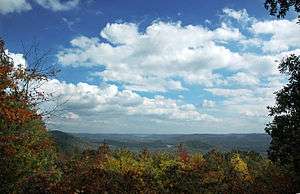Uwharrie Mountains
The Uwharrie Mountains (/juːˈhwɑːri/)[1] are a mountain range in North Carolina spanning the counties of Randolph, Montgomery, Stanly, and Davidson. The range's foothills stretch into Cabarrus, Anson and Union counties, and terminate in the hills of Person County.
| Uwharrie Mountains | |
|---|---|
 View over range from Morrow Mountain | |
| Geography | |
| Country | United States |
| State | North Carolina |
| Range coordinates | 35°24′07″N 80°03′32″W |
The Uwharries were once a coastal mountain range; isostasy has slowly raised the eastern seabed until today they lie in the Piedmont of North Carolina over 150 miles from the coast. Formed approximately 500 million years ago by accretion along the Gondwanan tectonic plate, they are thought to have once peaked at some 20,000 feet,[2] before eroding to a maximum of just over 1,100 ft. The range's high point is High Rock Mountain (1,188 feet/362 meters as measured by the NC Geodetic Survey), in southwestern Davidson County.
The Uwharries lie within the Southeastern mixed forests ecoregion.[3] They give their name to the Uwharrie National Forest. Once entirely cleared for timber and farmland, the mountains were designated a U.S. National Forest in 1961 by President John F. Kennedy. The woodlands have since returned, providing a haven for a diversity of wildlife, recreational facilities, and numerous Native American archeological sites.
In 1799, the discovery of gold at the nearby Reed Gold Mine in Cabarrus County led to America's first gold rush.
The North Carolina Zoo, America's first state-supported zoo, is located in the Uwharries region.
The Caraway Mountains, a segment of the Uwharries, are located in western Randolph County, west of Asheboro.
Protected areas
References
- Talk Like A Tarheel, from the North Carolina Collection's website at the University of North Carolina at Chapel Hill. Retrieved 2013-02-05.
- uwharries.com
- Olson, D. M, E. Dinerstein; et al. (2001). "Terrestrial Ecoregions of the World: A New Map of Life on Earth". BioScience. 51 (11): 933–938. doi:10.1641/0006-3568(2001)051[0933:TEOTWA]2.0.CO;2. Archived from the original on 2011-10-14. Retrieved 2016-07-07.CS1 maint: multiple names: authors list (link)
External links
- Uwharrie Forest page at UNC Asheville
- "Uwharrie Mountains". Geographic Names Information System. United States Geological Survey. Retrieved January 7, 2011.